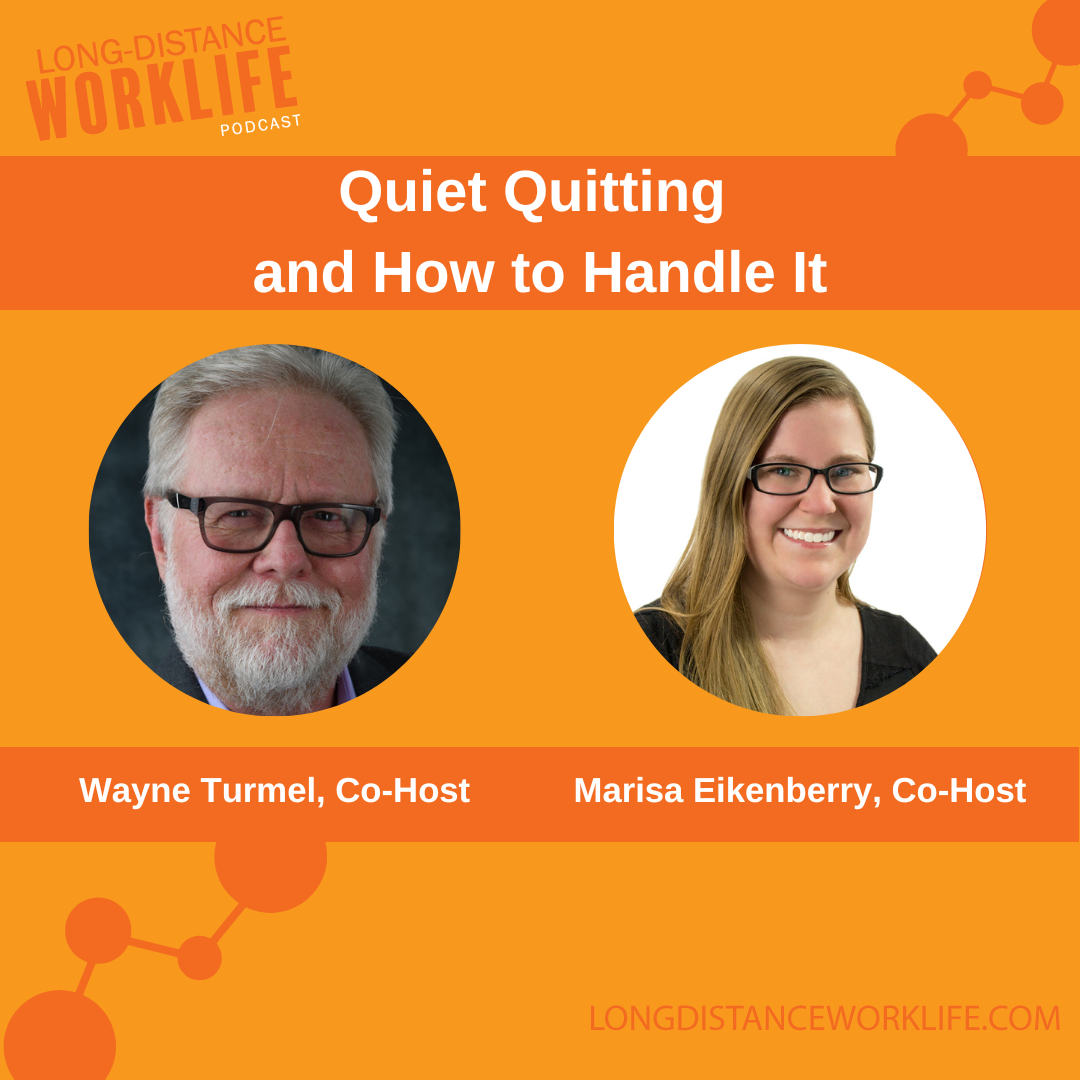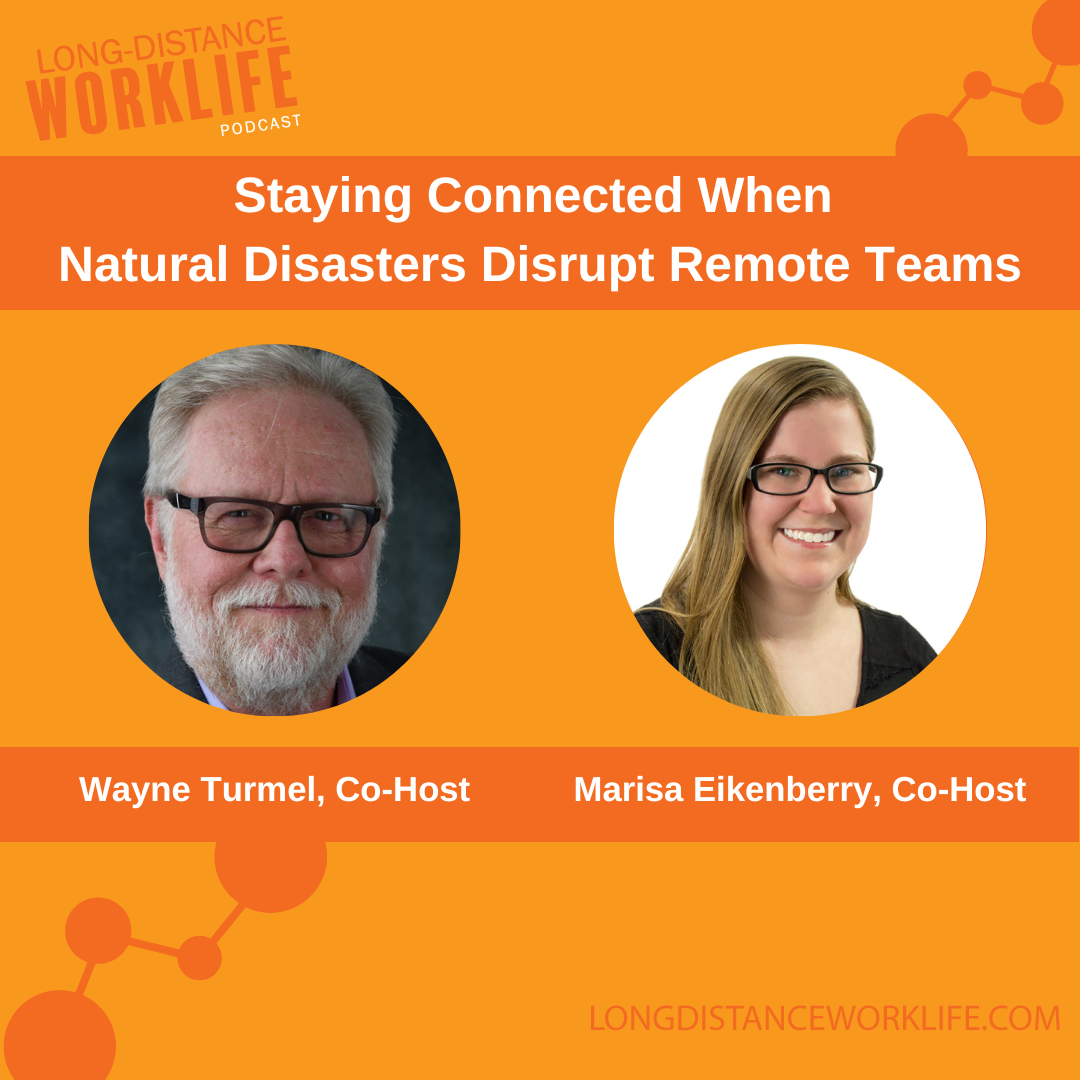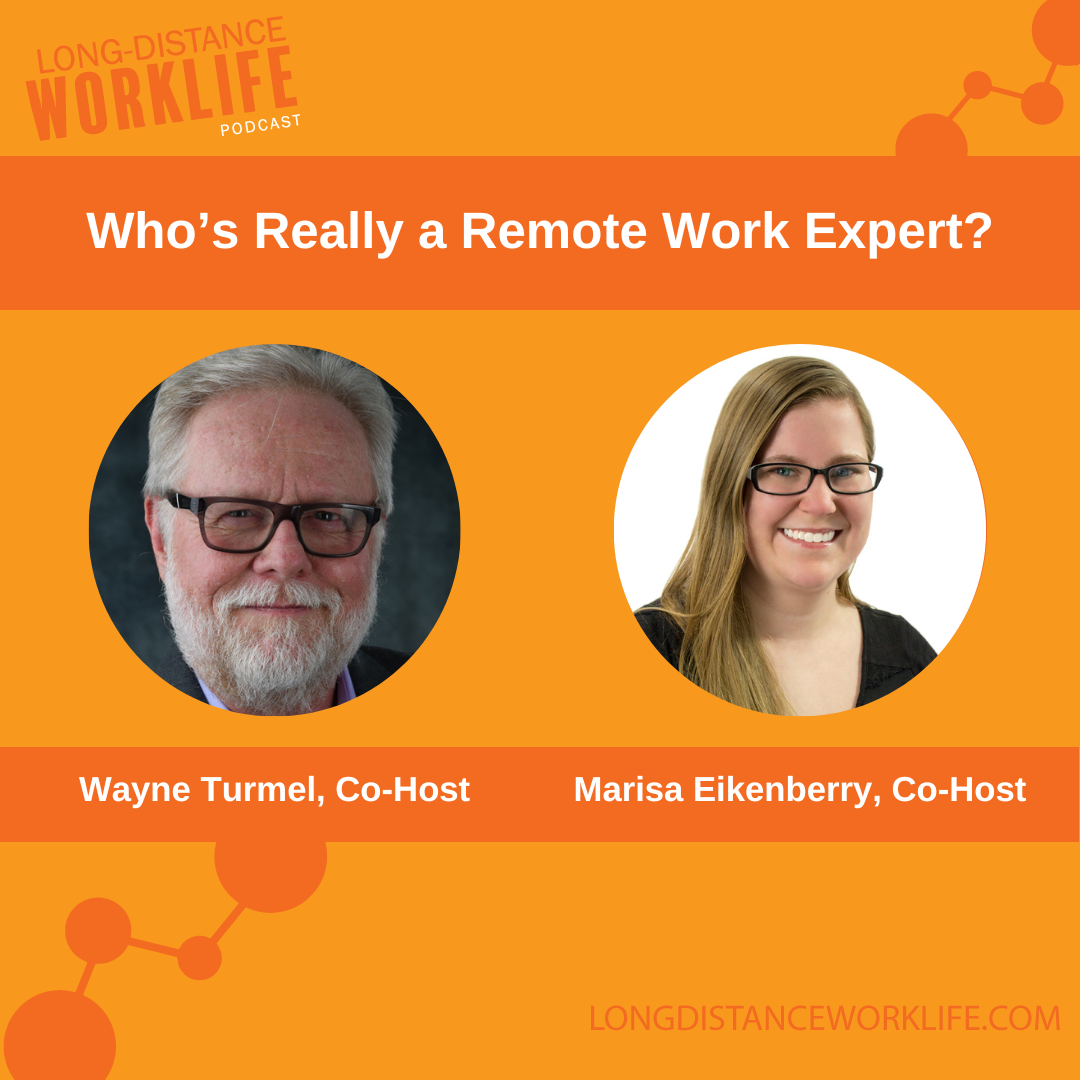You may have noticed some people talking about running out for an errand during their work day or moving some of their work to a time when they're more productive. Marisa asks Wayne about time shifting, or asynchronous work, and how to do it successfully in your organization.
Additional Resources
Free Video Series!
Join us for a powerful, 4-part video series titled, Demystifying Remote Leadership. You will learn how to create solid working relationships in a virtual team with more confidence and less stress!
Transcript
Marisa Eikenberry: Welcome to another episode of The Long-Distance Worklife. We're here to discuss and answer your questions about how to lead, work and thrive in remote and hybrid teams. I'm Marisa Eikenberry. Joining me is Wayne Turmel.
Wayne Turmel: That would be me. Hi.
Marisa: If you have a question that you would like us to answer, you can contact us on our website. Longdistanceworklife.com or e-mail. Email me directly at Marisa@KevinEikenberry.com. Wayne, today we're going to do one of our one topic episodes and I think we should talk about time shifting or how I've also heard somebody at GitLab describe it with asynchronous work.
So we're going to talk about what is it? When is it okay to do that kind of thing? Are you ready?
Wayne: It sounds vaguely science fictiony, right?
Marisa: Well...
Wayne: It's like we're going to time shift. You cannot do that, Captain.
Marisa: Yeah. Sounds like are about to jump into a time machine.
Wayne: Yeah. Basically, time shifting just means in our brains for the last hundred years, we've had this notion that a workday is 8 hours long and it starts at seven, eight, nine. Whatever time we start and it stops at three, four or five based on when you started. And regardless of where you work, every buddy that you work with is essentially on the same time schedule.
Marisa: Right.
Wayne: Right. That's kind of been the way it works. And for a lot of people with remote work, this means that people like me start work at 6:00 in the morning so that I am on pace with those of you back East And what we have found as people work remotely and they're working from home and they want more flexibility is that it is a mixed blessing, that kind of scheduling.
Yeah. And so people want to be able to work when it makes sense to them. Some people are morning people. It really doesn't bother me. Starting work at 7 a.m.
Marisa: Well, you're already your morning person, so that makes it.
Wayne: I'm already a morning person. And otherwise, you know, I'm sitting around for a couple of hours doing nothing until my workday starts and my body at 2:30 or 3:00 in the afternoon. Is that quite enough of that?
Marisa: Right.
Wayne: And so for me, I've actually been time flexing for a while. And, you know, if I have a class at 4:00 in the afternoon, I will take a couple of hours in the afternoon and take the dog for a walk or run my personal errands or do whatever. A lot of this has been stealth flexibility.
Marisa: Yes. I've seen that a lot, like on LinkedIn or something. I know that, you know, people say, hey, I'm going to go take a couple hours to go run an errand or they go on a walk or something. Somebody else I saw they they basically shift their day, kind of like what you were talking about earlier. And so they went outside and worked on their sidewalk in their yard for a couple of hours.
Because they're more productive at night. So they just kind of shifted everything over.
Wayne: And what it boils down to is what is the company's approach? We were talking a couple of shows ago about remote friendly versus remote first. It's the same thing with flexibility, right? You can have all the flexibility you want but if I'm in the office at 9:00 and I want to reach you and you're not there.
Marisa: Right? Yeah. It's not possible.
Wayne: Is your work really?
Marisa: Right.
Wayne: And so this is actually a pretty fundamental shift for a lot of organized machines, especially as they start to grow. Right. Because you start your company and you're living wherever you live. And, you know, you might have to adjust for customer time zones, but basically you work whatever time you work.
Marisa: Right.
Wayne: But now you hire somebody who lives in another time zone. Hmm.
Marisa: Yeah. Really changes everything.
Wayne: You know, and so when you think I mean, it's interesting because you work from home a lot, but I know that you maintain kind of traditional workplace hours. Yeah. Tell me, is that a conscious choice, or do you think you ought to do that?
Marisa: I think it's a little both. So, I mean, you know, for those of you who haven't joined us before, like working here at the cabin, I can bear group. This is my first job out of college. Like, I graduated on a Saturday, and my first day was Monday, so I don't really know any different. So when I first started there was definitely this idea of I start my day at eight and it ends at four.
Like, that's it. And I have kind of adjusted that sometimes a little bit as needed to like, you know, OK, I do have to go run an errand super quick or especially when lockdowns and stuff were happening, but you could like get out a little bit. My husband and I would jump in the car, "Hey, let's go get Taco Bell because we've been sitting in our house for two weeks."
Like, let's just get out somehow.
Wayne: For those of you listening, I am all about taking your spouse to lunch. I'm not sure that that would necessarily fit most companies health and wellness policies, but for sure.
Marisa: For sure. Yeah. So, you know, I mean, just little things like that. And I do know that there have been times that I have seen, you know, coworkers and stuff. Hey, I'm going to take the afternoon off or I'm going to, you know, jump off for a couple of hours. I'm going to come back on at night. I did this a little bit when I did work remotely full time many years ago, but it was for a particular project.
And it was just because the majority of the stuff that I was working on, I was working on at night, mostly because I couldn't get interrupted at night. So but that was that was a little bit of a different story. So I do think there's a little bit of I think for me, I like having a set schedule.
I like knowing that I'm going to start at eight and I'm going to stop at four. And that that's just it. I'm going to, you know, take a lunch break at noon. I personally like schedules, but that's just me.
Wayne: Now, I would say that it also helps that you are in the same time zone as the majority of people in the organization.
Marisa: Absolutely.
Wayne: So that it's very easy free for you to live on that schedule. There are three I wrote down three things as you were talking. The first is when we're talking about asynchronous work, it kind of raises the issue of how much synchronous work do really need. So if your job is leave me alone, let me get my work done, and I don't need to interact with other people in order to make that happen.
It matters less whether I am sitting at my desk at a given time right Absolutely. What matters and this has to do with a whole approach to leadership and managing performance is are you measuring behaviors such as when do you show up and when do you go to work? Or are you measuring the work that gets done? If reports need to be done Friday, and you don't need my input on that.
I don't really care what time of day you work on it. Yeah, depending on your family situation, depending. In this case, it's just you and Parker, so you want to sync your schedules so that you are both available at the same time and yes, free time. So that is part of the equation. You know, this whole idea of what is the work that needs to be done and what's the best way to do it.
Right. A lot of us started working from home so that we can get stuff done.
Marisa: Right? Yeah. Because the work still has to get done.
Wayne: So you know, when you're thinking about it is what's the work that we're doing? When do we need to be synchronously available? Now, that's going to depend on the job, right? If you're in a customer service job, you need to be available when customers expect you to be available, whatever. Right outside that is, you may have internal customers that you need to be immediately responsive to.
So that's part of the discussion is you setting up what are my work hours, how flexible can I be? Is what are the things that have to happen in order for the work to get done?
Marisa: Yeah, and I think with that, too, I mean, you were mentioning like customer service hours and stuff, and there's a small and small. It's not really quite accurate, but there is a piece of my job that is customer support. And so I have to be around to answer support tickets and stuff like that because, you know, when I'm not doing that, well, somebody else is doing that and that's OK because that's his business.
And, you know, he answers them in the off hours. But to your point, like I try to make sure that I'm available during those hours expecting that that's when I'm going to get the majority of those support tickets. But most of my other projects, it doesn't really matter what time I'm doing those.
Wayne: Yeah. And so the other thing that you said to me, which is kind of interesting, is I take an hour for lunch or I do this. The problem with working from home for a lot of people is they have this in their head that they've got to work. They but they take that to the point where they always have to be available.
And so there are a lot of people who don't take the breaks that they would take in the office. They don't take an hour for lunch. They don't get up from their desk every hour and a bit and stretch their legs and get some oxygen and do what they need to do. So that notion of wanting to be responsive to customers, wanting to be responsive to their teammates.
Afraid they're going to miss a message stops people from actually leveraging the flexibility.
Marisa: Yeah, I was you know, when you're talking about that, I was guilty of that when I first started working for Kevin and you. Yeah. I was gonna say, I know I was and I've gotten a lot better since I got married, but, you know, I know that I was somebody who was in and I accidentally trained the team to expect this of me, which was my fault entirely.
But just this idea of, well, I'm tech support, so I have to always be on well, first of all, nobody's dying in tech support. Like, it can wait until later, almost always. But, you know, so I was setting this expectation up that I was available all the time. So if you sent me a Slack message at 7 p.m., I was going to answer you.
Why? Because I lived alone and I didn't have anything better to do. To be quite honest about it, you know? And so once I got married and I went to remote working full time, one of the things I knew that I had to do was I'm going to walk into, you know, we had a bedroom set up for our office.
And so when I walked into that room, OK, I'm starting my work and at 4:00 I'm leaving and that's it. And I had my Slack set to do not disturb and all of that stuff. I mean, yeah, there were occasions that somebody might message me and I might still respond, but now there's, you know, a new culture essentially that I had to train everybody with for myself personally, that if it's after 4:00 and you send me a message, I'm not seeing it until the next day.
So if it's really important, you need to call me and that's almost never happened.
Wayne: Well, and even if I do see it, I can guarantee and I'm going to answer it.
Marisa: I'm so thankful for the Slack remind feature because there are some times where, yeah, I'll see it, but it's right at the end of my workday. And so it's like, you know, I see this, you know, I might respond, but I'm not taking care of this until the next day. And some Slack will remind me about it the next day, and I go from there.
Wayne: Well, as so often you've said a couple of things just in passing, like does that actually require some thinking? Right. If you're going to time shift as a policy for an organization, for example, what time is everybody else working? You know, if the goal is somebody has to be there to answer the phone or somebody has to be there if you've got three people on your IT Team, all three people don't have to be available at the same time.
Marisa: Right.
Wayne: Right. So if you've got somebody on the East Coast and they start their day earlier and somebody on the West Coast who can finish up at the end of the day, great. Make a work absent. You've got somebody who's an early bird is up early anyway. Let them work when they're good and somebody else. As long as the mission critical things are covered.
Marisa: Yeah, it reminds me, I know I mentioned this slightly in passing a little bit ago. So you know, we sell DISC assessments with the Kevin Eikenberry Group and discpersonalitytesting.com and I do customer support on that site and there are only two people on the customer support team. It's me and one of our co-founders. And so, you know, I try to take care of the tickets between eight and 4:00 so that way that can free up him to do the stuff that only he can do.
And, you know, I just message him if I need to, if there's a support ticket that I just don't know how to handle. But after 4:00, that's all him because, you know, A, it's his business. So that makes sense. And then he can adjust and decide, do I want to take these at night or not, you know? And so, I mean, there's also even a little bit of training customers to know like you send me an email 2:00 in the morning because you're in Australia, we're not answering it until 8 a.m. at least.
Wayne: That's, you know, my friends customers in Australia.
Marisa: Absolutely.
Wayne: Or clearly.
Marisa: We love them just the same.
Wayne: Right? It's just the reality of the situation. And as the workplace changes, we need to make those kinds of decisions when is it important that somebody be there immediately to respond? And when does a reasonable time frame to respond makes sense? The whole idea of we have to be available to each other synchronously is what is leading to people putting in too many hours and people being on Zoom meetings from beginning of the day to the end of the day.
One of the things about hybrid work and we've talked about this before and we'll continue to say it until people figure it out.
Marisa: Absolutely.
Wayne: Is that hybrid is not just like the office, but with webcams.
Marisa: Yes. Even though people are trying to make it seem that way.
Wayne: Well, and they always have because that's what we know. That's how we've always done stuff is we get together and have a meeting.
Marisa: Right.
Wayne: For hybrid work to truly work for flexible workspace time flex to work to be able to really happen, we need to reexamine how the team works together. And that means leveraging asynchronous tools. You mentioned whether it's Slack or Microsoft teams, we do a really good job, although it's time to go in and do a cleanup of having very mission specific groups.
Marisa: Yes, yes. Specific channels for different things.
Wayne: So that if you have a question about something that the whole organization doesn't have to be on the clock. In order to answer that, you just need to know that the other person in that conversation is going to answer you.
Marisa: Right?
Wayne: That is much easier to negotiate.
Marisa: Well, and I think our team is also really good about using the Do Not Disturb features in general to to let you know, everybody know, hey, I'm heads down for a couple of hours, I'm going to change my Slack status. And, you know, if you really need me, call me or you know, like I said, I end my day at 4:00, my Slack goes in a Do Not Disturb mode and you can see that I'm not available.
Wayne: The other thing that you said just kind of in passing and I can't stress this enough because this is traumatic for a lot of people is this notion that we teach people how to work with us.
Marisa: Yeah, absolutely.
Wayne: We teach people it's like if I am constantly if I tell you I'm in a meeting, but I'm still answering your messages and answering your emails, I have told you it's perfectly OK.
Marisa: Yeah.
Wayne: To bother me in the middle of a meeting whereas if it says Wayne's in a meeting till 2:00 and you hear from me at 205, the message is I was in a meeting right? As time shifting and flexibility becomes more important, not only do we have to get better about setting boundaries, right? The other people on our team need to respect those boundaries.
Marisa: Yes.
Wayne: And that is it's funny. People will be much better about respecting those boundaries than we are about setting them just right and one of the reasons for burning out when you work from home comes from a bunch of guilt and wanting to take one for the team and being a good teammate to the point where you are draining your own resources and for flexibility to work we need to be able to set expectations for the company.
I mean, let's start with you're getting paid to do a job. Absolutely. So the job is going to have certain expectations. Yes. Now, with that, what requires you to be synchronous with the rest of the team? What does we figure that out? What is the expected availability? What is the expected response? Time to messages and whatever what are the tools that we are expected to use?
Marisa: Right, Google Drive, Slack, whatever. And I know there's a lot of asynchronous tools coming out all the time, too.
Wayne: Yeah. And new tools every day. And that's a whole other a different. That's a whole other source of service that we don't want to get into. But, you know, these are the things that we need to determine. These are the things and they may be up for review.
Marisa: So with that, I know that you're mentioning a lot of stuff that, you know, us as workers can do and, you know, ask our leaders about. But I guess from a leaders perspective, how do you set these boundaries? I mean, you know, are some people just waiting until they come up? Should we be trying to make that culture ahead of time?
Wayne: There are a couple of problems that's a fabulous question. Yes. The organization should be thinking about this. And if you are in HR or you are in operations and you're trying to figure out how do this work, start doing your research. There's plenty of good work out there. Long distance leader or Teammate.
Marisa: Links in the show notes.
Wayne: And in bunches of other content which will tell you what you should be think about. The problem is that a lot of senior executives have never worked in a flexible environment. They've always worked sometimes literally nine to five.
Marisa: Right.
Wayne: But they've always worked in a highly structured environment. And so if you're coming from that environment and you're trying to adjust, you don't know what you don't know that's true.
Marisa: Absolutely.
Wayne: So having the company make all the decisions makes no sense, right? What needs to happen is you need to sit with your team and you need to say, OK, what is the work that needs to get done? What is the mission critical work that absolutely has to be done synchronously what can be done asynchronously with a giant asterisk and what doesn't matter where it happens and when that happens.
Marisa: Absolutely.
Wayne: Set those boundaries, set those expectations and let people tell you how this works. And then and this is the part that people stress about just because you set a policy doesn't mean that's written in stone by a month, two months, three months. Is the work getting done? Our customer complaints rising is there you know, is working with the other parts of the organization, creating a problem and then reexamine it and do the process again until you find something that works?
Marisa: Yeah, we always reserve the right to be smarter.
Wayne: There you go. I think looking at the time, good lord, as always, that's probably it. But, you know, if you're looking for the the nutshell of this whole thing, it's what's the work that needs to be done, really not your preference, what really needs to be done synchronously and asynchronously.
Marisa: And sometimes meetings are not it.
Wayne: Not it. And sometimes they are right right. So here's the thing. If you have, if you're in the middle of your flex time and there needs to be a meeting, does it matter that you are in a baseball cap and t shirt? Probably not.
Marisa: Yeah.
Wayne: Right. Do the meeting. Do what you need to do and go back to your life up until it's time for you to do more work. So this is going to be an ongoing process. We're going to constantly be learning about this, and we need to be open to constant reexamining in order to find the optimum way to make time shifting work sounds great.
Marisa: Thank you so much for answering this question today, Wayne. I think we had a great conversation today.
Wayne: Well, you answered as much of it as I did, which is the way this is supposed to work, frankly.
Marisa: Again, we're getting smarter all the time. So thank you so much for listening to another episode of the Long-Distance Worklife. If you'd like, we'd love if you would write, review and subscribe and tell your friends about us. We're on YouTube and everywhere that you get your podcasts, you can also connect with us at longdistanceworklife.com.
And we would love to answer your questions in a future episodes so you can either contact us on the website or email me directly at Marisa@Kevin Eikenberry.com. Thanks for listening. We'll see you next time.




